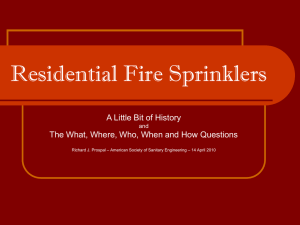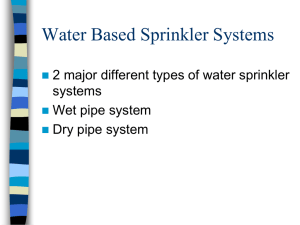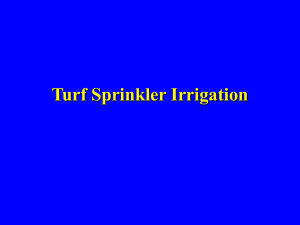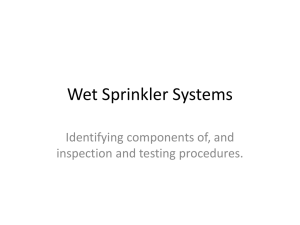Firefighter III Module C Sprinkler Systems
advertisement
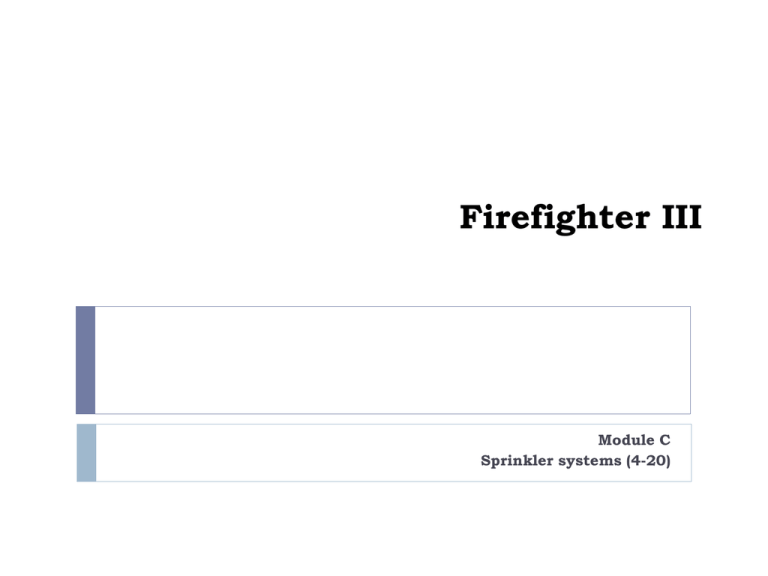
Firefighter III Module C Sprinkler systems (4-20) Know parts & function NFPA NFPA 13: Sprinkler System Installation NFPA 13A: Care & Maintenance NFPA 13D: Standard for Installation of Sprinkler Systems in One & Two Family Dwellings & Mobile Homes. 3-14.1. Identify the reliability of automatic sprinkler systems: (4-20.11) A Reliability of automatic sprinklers: a) Most reliable form of fixed fire protection. b) Multiple death never recorded in completely sprinklered building with a properly working system. c) Less business interruption. d) Less water damage than conventional firefighting. e) 70% of all fires controlled by activation of five or less heads. QUESTION!!!! 3-14.2. Identify eight reasons for unsatisfactory performance of automatic sprinkler systems: (420.11) A Unsatisfactory performance: a) Partially or completely closed main water connection. b) Interruption to the municipal water supply. c) Damaged or painted over sprinklers. d) Frozen or broken pipes. e) Excess debris or sediment in the pipes. f) Failure of a secondary water supply. g) Poor or improper maintenance of the system. h) Closing the valve before complete extinguishments. i) of 4% of fires not controlled by fires, 35% of fires were due to the valve being closed 3-14.3. Identify five sources of water supply for sprinkler systems: (4-20.1) A Sources of water supply: a) Public water system. b) Gravity tank. 35 ft. above highest head. c) Pressure tank. d) Reservoir with fire pump. e) Storage tank with fire pump. f) 2nd independent water supply may be required. g) supply enough water volume to the highest head & maintain pressure at head at 15 psi. (Question will ask if the pressure should be maintained @ 30 psi.) 3-14.4. Identify two methods of determining water flow through a fire department connection check valve. (4-20.2) A Observe any arrows on the casting. Question: Arrow points away from water flow direction on a F.D.C.? B Observe the appearance of valve casting. 3-14.5. Identify the location and appearance of the following control and operating valves of a sprinkler system: (4-20.3) A Location and appearance of sprinkler system valves. 3-14.5. Identify the location and appearance of the following control and operating valves of a sprinkler system: (4-20.3) 3-14.5.1. A. Outside screw and yoke: (OS & Y) A Location: a) Located between water supply and the sprinkler system. b) Usually immediately under the sprinkler alarm valve. B Appearance: Threaded portion of stem is out of the yoke when on and inside when off. 3-14.5.1. A. Outside screw and yoke: (OS & Y) Question: From picture Identify that this is an OS&Y. Question: Determine if the valve is open or closed from this picture. 3-14.5. Identify the location and appearance of the following control and operating valves of a sprinkler system: (4-20.3) 3-14.5.2. B. Post indicator valve: (PIV) A Location- usually located outside the building. B Appearance: a) Hollow metal post. b) Movable target on stem to indicate valve position. c) Handle stored and locked in position. 3-14.5. Identify the location and appearance of the following control and operating valves of a sprinkler system: (4-20.3) 3-14.5.3. C. Wall post indicator: A Location- Extends through the wall. B Appearance- Similar to PIV. 3-14.6. Identify the main drain valve on an automatic sprinkler system: (4-20.3) A B C) Location- Near alarm valve. Appearance- Usually hand wheel type valve. Question: 2” or larger diameter!! Know this picture, because you will have to label it!! 3-14.7. Identify the dangers of the premature closure of a sprinkler main control valve: (4-20.6) A May lead to dramatic increase in the intensity of the fire. 3-14.8. Identify the dangers of using hydrants to supply hose streams when the same water system is supplying the automatic sprinkler system: (4-20.6) A a) b) Use of hydrants in the area: Should be avoided if at all possible. If necessary monitor the performance of sprinklers. 3-14.9. Identify the difference between an automatic sprinkler system that affords complete coverage and a partial sprinkler system: (4-20.7) A Complete- Entire building is protected by sprinklers. Partial- Only certain areas are protected by sprinklers. (High Hazard Areas, Exit Routes, or places designated by code or by the A.H.J. On this know, Examples of buildings or situations. Residential is one of the possible answer to select from. 3-14.10. Identify the following types of sprinkler systems: (4-20.8) 3-14.10.1. Wet pipes: A Used in locations that will not freeze. B Contains water under pressure at all times. C Usually equipped with an alarm check valve. D May also be equipped with a retard chamber: a) Used in conjunction with the alarm check valve. b) Catches excess water from pressure surges. c) Used to reduce the change of false alarms. d) Water drains from the chamber through a drain located at the base. E To shut the system down- turn off the main control valve and open the main drain. 3-14.10. Identify the following types of sprinkler systems: (4-20.8) 3-14.10.2. Dry pipe: A Used in locations subject to freezing. B Contains air under pressure above the dry pipe valve. C When activated, air must first escape before water is discharged. D Small amount of air pressure holds back a large amount of water. E May be equipped with devices to quickly expel air: a) Accelerator-permits air to enter the intermediate chamber, equalize the pressure and open the clapper valve faster. b) Exhauster- Activation opens a large valve which permits air to quickly escape. Accelerator & Exhaustors have separate question asked as well! Question: Know differences between wet pipe & dry pipe. Question: Know difference between pre-activated & deluge. Pre-Action System Question: A pre-action system is a dry system which employs a deluge-type valve, fire detection devices, and closed sprinkler heads. This is especially important when water damage needs to be prevented, even if the pipes should break. A system which contains over 20 heads must be supervised so that should the detection system fail the system should be operated automatically. 3-14.10. Identify the following types of sprinkler systems: (4-20.8) 3-14.10.3. Deluge: A. system is usually equipped with open sprinklers and a deluge valve. B. Usually used to protect extra hazardous occupancies. C. Upon activation, water is discharged from all sprinkler heads. D. Activation is controlled by heat and/or smoke detectors or manually. 3-14.10.3. Deluge:(cont.) Question: This system is ordinarily equipped with open sprinkler heads & a deluge valve. Fire detection devices are installed in the same area as the sprinkler heads. Upon fire detection, the deluge valve is opened, which permits water to flow into the system and out of all the sprinkler heads. 3-14.10. Identify the following types of sprinkler systems: (4-20.8) 3-14.10.4. Residential: A Used in one and two family dwellings. B Designed to prevent total involvement in the room of origin. C Systems may be wet or dry. D Use “fast response” sprinkler heads. E May use special plastic pipe. F May be connected to either city water source or a private water source. G Usually not connected with fire department connection. 3-14.11. Identify obstructions to sprinkler heads and the required clearances: A a) b) B Types of obstructions: Stock. Partitions. Clearance- 18 inches from deflector. 3-14.12. Identify the automatic sprinkler requirements for rack storage: A Storage height- Discharge density based on storage height. B Aisle width- up to 25 ft. high sprinkler density based on aisle width. Question! C In-rack sprinklers- number and arrangement are influenced by height of storage and aisle width. D Temperature rating of ceiling sprinklers- influenced by in-rack sprinklers and height of storage & aisle width. Question! E Clearance below sprinklers- maximum distance is a factor. F Clearance of at least 18” should be maintained under sprinklers measured from deflectors. Question! sprinkler requirements for rack storage: A Type system-= dry pipe or wet pipe influence discharge densities. B Pile stability- difficult to determine under fire conditions. C Encapsulation- need for higher density if present. D Smoke venting- may or may not be of value. E High-expansion foam- Reluctance to use because of cost factors. F Sprinkler orifice size- dependent on desired densities. Inspecting the System Question: System’s air pressure is maintained at 15-20 psi above the trip point and no air leaks are indicated by rapid or steady air loss. Question: From this picture, you will have to determine which one is correct! Now You Know! 3-14.13. Demonstrate opening and closing the main drain valve on an automatic sprinkler system. (4-20.5) 3-14.14. Demonstrate reading and recording the indicated pressures on all gauges provided on a standard wet pipe automatic sprinkler system and identify each gauge. (4-20.9) 3-14.15. Demonstrate reading and recording the indicated pressures on all gauges provided on a standard dry pipe automatic sprinkler system and identify each gauge. (4-20.10)
